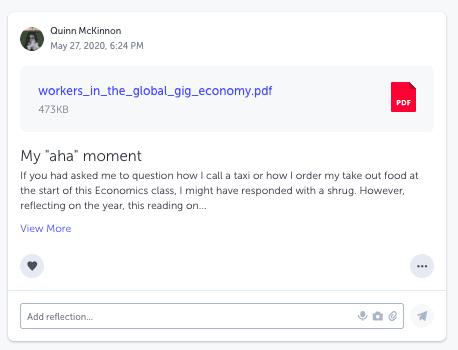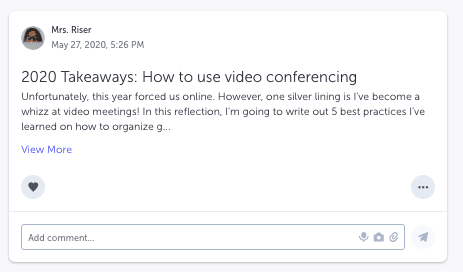Finding the best way to conclude a school year is a challenge, even in the best of times.
How do you help students not only showcase their learning from the year but also see it for themselves?
Final exams, presentations, essays, and other capstone projects, are all common tactics to assess students’ learning from the term; but each of these tasks focuses on creating one ‘event’ or instance for the student to be evaluated against.
Yet, learning happens over time.
Exit portfolios present a solution for educators and students by helping provide closure on a school year, documenting learning events, and inviting students to reflect on their growth. An exit portfolio assignment invites students to review their work from your class and tell a story related to that journey.
Rather than simply saying “here is my best work,” an exit portfolio invites students to select evidence of work where they learned the most, had the biggest challenges, and work that made them most proud.
Why create an exit portfolio?
Exit portfolios can be powerful tools for teachers and students.
For a teacher, it allows the student to drive their own reflection and take ownership of their learning. Your students will surface the work that they feel was most influential on their learning, rather than you telling them what work stood out the most to you.
For a student, it forces them to go back and read their own writing, reflect on how they approached past problems, and re-consider their approaches through the process.
Starr Sackstein, educator, blogger (mssackstein.com), and author of numerous books, including Hacking Assessment, shared her recommendations for educators looking to create exit portfolios with their class.
“When you see a portfolio that’s done well, you can literally see the learning from artifact to artifact,” Sackstein said.
The exit portfolio gives students a chance to tell the story, through their own work, of what and how they learned.
“Teachers can start by asking students to brainstorm major assignments and learning to connect with what was most salient. They may even provide a Google form or other survey in order to help students remember the learning,” she suggested.
Read: "Instead of Standardized Testing, Consider Portfolio Assessment" by Starr Sackstein in EdWeek
Making up for lost documents
Thinking ahead to next year, creating a digital portfolio is also a great opportunity to get yourself and your students in the habit of digitally documenting student work. However, if you're reading this as you're wrapping up the school year, it's a little late to change the past.
If you have a heavily print-based class, you and your students may have a tougher time this year, especially due to the transition to remote learning.
Students who had their lockers filled with loose assignments may not have brought everything home, or perhaps some student work is still with the teacher for feedback.
That’s okay.
Students can still reflect on learning without specific artifacts: Have them explain the lesson or takeaway that resonates with them and expand upon why it’s memorable or meaningful.
“Where work may be missing or absent, teachers can allow students to reflect on learning in a variety of ways that can connect to the works they do have access to,” said Sackstein.
“The point of the exercise being to allow students to show what they know and can do and what they learned specifically this year.”
Ideas for various grade levels
Primary/Elementary School:
-
- Students can select work samples they are proud of from various subjects and explain their selection in a video recording directly from their SpacesEDU student account.
- Students can create an ABC memory booklet to jot down memories or skills they acquired throughout the school year. To add an academic touch to the activity, you may set a requirement for it to be solely based on the learning objectives you focused on as a class.
- Students can share an area they want to grow in.
Secondary School:
-
- Students can select work samples, such as research papers, essays, lab reports, or projects, that demonstrate their mastery of subject matter in various disciplines.
- Students can include artistic and creative projects, such as drawings, paintings, sculptures, or performances, that reflect their talents and skills.
- Students can outline extracurricular activities, such as clubs, sports teams, or volunteer work, that show their involvement and leadership skills in school and community.
- Students can write personal reflections that demonstrate their critical thinking skills, self-awareness, and growth mindset.
- Students can share their achievements, such as awards, certificates, or other forms of recognition that they have received during the school year.
Prompts to encourage end-of-year reflection remotely
-
- Write a letter of advice to share one of your learnings to a student entering that grade next year
- Write a letter to yourself: Knowing what you know now, if you could send a letter back in time so that you would receive it at the start of the school year, what advice would you give your younger self?
- Reflect on one highlight or memory from this school year
- Choose an in-class discussion [or activity/reading/chapter/experiment] and how you’ve applied it to your life
- Share one thing you are most proud of accomplishing this school year
- If you had to re-do any assignment this year, now that the year is wrapping up, what assignment would you re-do? Walk me through how you would tackle it differently.
- Answer the following question with any media format: If you could go back in time and restart the school year, what would you do differently and why?
- Answer the following question with any media format: What's one word or image that could describe your school year? Explain why you chose this artifact.
- Answer the following question with any media format: In what area of this class do you feel you made the biggest improvements? How so?
If you decide to continue this assignment in future years, it’s a great opportunity to start exploring tools to document student assignments, like SpacesEDU, or to encourage students to keep a backup of their work on your LMS.
Whether you want to simply take photos, scan documents directly to Google using an Android phone, or use a third-party scanning app, there are a number of ways to digitize your students’ work for easy, online collaboration.
Here’s one example of a student reflecting on one of our biggest accomplishments from Food and Nutrition Class.

Here’s another example of a student reflecting on a reading from the class that changed her perspective.

Is there a low-tech option for exit portfolios?
For students with limited tech access at home, compiling a print portfolio is a great solution to close the year.
While students creating print portfolios will not have the same flexibility of media types, such as video and audio recordings, they can still use words, work samples, and photographs to reflect upon their learning effectively.
Be sure to communicate to students that it’s okay to create a print portfolio and that they will not be penalized for completing the assignment in a different way.
Capstone projects vs. exit portfolios
Before speaking with Sackstein, I’ll admit it, I thought exit portfolio and capstone project were interchangeable. But it’s important to note that these two types of culminating assignments can overlap or can be entirely different.
Unlike an exit portfolio, a capstone project may stand alone from other work completed through the year. A capstone project is typically a major assignment that pulls together elements and learnings from the whole school year. Perhaps it’s a research project, a presentation, a report, or an experiment that ties together all of the key learnings from the course.
Considering a capstone projects' place within an exit portfolio, a final capstone project very well may be a major artifact the student highlights. However, in an overarching exit portfolio, the different coursework that led up to helping the student choose that topic or theme could also play a role in telling the whole story.
Likewise, a teacher may assign an exit portfolio itself as a capstone project, asking students to curate their work for a final presentation or package.
How to get started
Ready to have your students create an exit portfolio? Get started with these three steps:
Explain the why
Like any assignment, students will have more buy-in if they can see the “point” of what they’re doing. As they say best, “why does this matter to me?”
Be sure to give students the context on why they are being asked to put together an exit portfolio. Offer out any guidelines or recommendations you have for ensuring their success.
“Teachers should talk to students frankly about the importance of student buy-in and give students a forum for discussing their concerns and questions,” suggested Sackstein.
Keep it simple and flexible
The reflection component is the most critical part of this assignment. So, it’s up to you how many ‘guidelines’ you want to give students for selecting and documenting work.
Your school or your curriculum may require portfolios to be organized in a specific way. However, if you're able to do so, give students as much flexibility as possible with how they can reflect.
For example, allow multiple media types, such as video, audio, images, and text. A variety of media allows students to respond in the way they’re most comfortable and allow you to meet the needs of all your learners.
There could be students in your class who thrive writing a short essay or poem, some may prefer to speak their thoughts into an audio or video recording, and others who prefer to draw out a diagram.
“Encourage students to be creative when putting together learning,” said Sackstein.
Create your own!
Let’s be serious, we could all benefit from taking a pause and reflecting on this strange school year.
Consider creating your own exit portfolio as an example for the class. Not only will your example help set expectations, it will be fun for you to consider your own learning moments from the year.
Here’s a quick sample from one teacher’s exit portfolio on learning about video conferencing.


